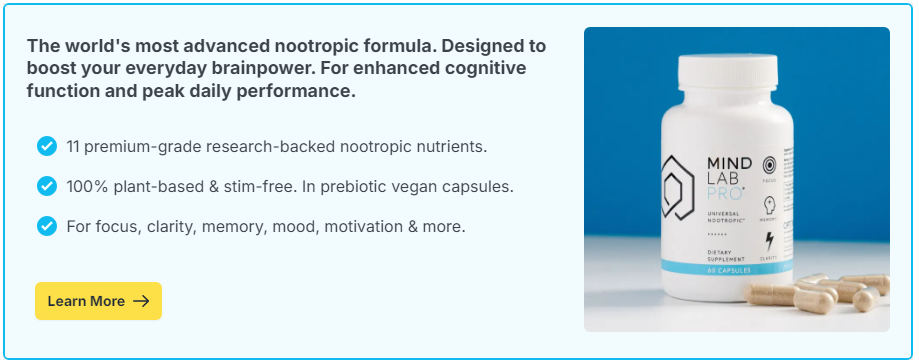
Flow feels like the mind breathing on its own. Thoughts pass without tugging, attention holds steady, and time loosens its grip. Many meditators chase this feeling only to bump into restlessness, drowsiness, or a jumpy mind. Good news: you do not need incense and a mountaintop. You need a simple practice, a helpful environment, and, for some people, carefully chosen nootropics that support calm alertness.
Contents
- Why Flow Slips Away During Practice
- Foundations First: The Practice That Builds Flow
- Nootropics That May Support Calm Alertness
- L-Theanine For Relaxed Focus
- Rhodiola Rosea For Perceived Fatigue
- Citicoline For Clean Mental Energy
- Lion’s Mane Mushroom For General Cognitive Support
- Phosphatidylserine For Stress And Switching
- Bacopa Monnieri For Memory And Learning
- L-Tyrosine For Acute Strain
- Maritime Pine Bark Extract For Circulation Support
- Match Compounds To Meditation Styles
- Breathwork And Micro-Resets That Welcome Flow
- Design A Practice Environment
- A Sample 20-Minute Flow Practice
Why Flow Slips Away During Practice
Meditation asks for relaxed focus. Too much arousal and attention scatters. Too little and you nod off. Knowing the common culprits makes it easier to tune your practice.
Overarousal And Restlessness
High stress, heavy caffeine, or late screens can leave you revved. The body sits still while the mind keeps sprinting. Flow rarely visits a clenched jaw.
Underarousal And Sleepiness
Big meals and dim rooms invite drowsiness. The mind fades, attention melts, and the session becomes a nap with good posture.
Wandering Without Structure
Jumping between apps, timers, and techniques makes progress slow. A simple, consistent method lets the mind learn what to do without extra decisions.
Foundations First: The Practice That Builds Flow
Nootropics are not shortcuts to enlightenment. They work best on top of steady habits. Set up the basics and you give flow a place to land.
Pick One Core Technique
Choose breath awareness, a body scan, or a simple mantra. Stick with it for at least two weeks. Consistency teaches your attention where to rest.
Anchor Your Session
Use a brief ritual, sit down, two deep breaths, soft gaze, then begin. An anchor tells your nervous system that it is safe to settle.
Light And Posture
Sit upright with a relaxed chest and long neck. Keep the room gently lit. A small lift in arousal prevents a slide into sleepiness.
Short, Daily, Then Stretch
Start with 10 minutes daily for one week. Add 2 to 5 minutes each week until you reach a comfortable 20 to 30 minutes. Small wins build momentum.
Nootropics That May Support Calm Alertness
Some compounds are used by meditators and performers to balance focus with ease. This is not medical advice. If you have a condition, are pregnant, or take medication, speak with a clinician first. Start low, add slowly, and track how you feel.
L-Theanine For Relaxed Focus
L-Theanine, the amino acid in tea, is known for promoting a calm yet attentive state. Many people find it helpful before seated practice, especially when paired with a small amount of caffeine earlier in the day.
Rhodiola Rosea For Perceived Fatigue
Rhodiola is an adaptogenic herb used to support stress resilience and motivation. Earlier day timing is common for people who feel flat or foggy during practice.
Citicoline For Clean Mental Energy
Citicoline provides choline for acetylcholine production and supports cell membranes. Users often describe crisp engagement without a wired feel, which can help attention rest on the breath or mantra without drifting.
Lion’s Mane Mushroom For General Cognitive Support
Lion’s Mane is popular for overall cognitive wellness interest. Some practitioners like it for a gentle sense of clarity during longer retreats or study periods.
Phosphatidylserine For Stress And Switching
Phosphatidylserine is a structural phospholipid in brain cells. It is studied for memory and stress response. Meditators who blend practice with busy schedules sometimes find it helpful when shifting between tasks and calm sits.
Bacopa Monnieri For Memory And Learning
Bacopa is commonly used for memory. Effects are gradual, typically building over weeks, which suits students of contemplative texts or those tracking subtle changes in attention quality.
L-Tyrosine For Acute Strain
L-Tyrosine is a precursor for dopamine and norepinephrine. During sleep restriction or high stress days, some people use it earlier to support working memory during mindfulness training. Avoid close to bedtime.
Maritime Pine Bark Extract For Circulation Support
This extract provides proanthocyanidins with antioxidant activity and is often used for healthy circulation. Some practitioners feel it supports alertness during longer sits.
Match Compounds To Meditation Styles
Different practices ask for different mental tones. Use this menu to align your approach with your chosen technique, always within personal tolerance and medical guidance.
- Breath Awareness: L-Theanine before a 20 minute sit to smooth edges and reduce fidgeting. If you use caffeine, pair lightly and earlier in the day.
- Focused Attention On A Mantra: Citicoline may help sustain clean attention during repetitive phrasing without drifting into autopilot.
- Open Monitoring: Phosphatidylserine for those who switch between sensations and thoughts while staying relaxed. Keep posture upright and room gently lit.
- Study And Reflection: Bacopa Monnieri used consistently supports retention of teachings and journaling insights.
- Retreat Or Long Sits: Earlier day timing of Rhodiola may help perceived fatigue. Some people also use Lion’s Mane or maritime pine bark extract as part of a broad routine.
Breathwork And Micro-Resets That Welcome Flow
Supplements can support a steady mind. Techniques teach that mind how to settle.
Physiological Sigh
Two short inhales through the nose followed by a long exhale through the mouth. Repeat three times before you begin. This lowers stress reactivity and helps attention land gently.
Extended Exhale Breathing
Inhale for four counts, exhale for six to eight. Longer exhales engage the calming branch of the nervous system without making you sleepy.
Labeling And Letting Go
When distractions appear, label them softly, hearing, planning, or itch, then return to your anchor. Naming reduces the pull without a fight.
Design A Practice Environment
Flow visits rooms that make focus easy. Small changes matter.
Simple, Consistent Space
Pick a corner with a cushion or chair. Keep it tidy and consistent. The brain learns to shift gears when it sees the setup.
Light, Sound, And Temperature
Use soft light, reduce harsh noise, and keep the room cool enough to prevent drowsiness. A light blanket can reduce fidgeting without creating heat.
Timer And Journal
Pick a gentle timer and keep a small notebook nearby. After each session, jot two lines: what you noticed and one intention for tomorrow. This track record encourages patience and progress.
A Sample 20-Minute Flow Practice
- Before you sit: Two minutes of light mobility. If caffeine makes you edgy, pair it with L-Theanine earlier. Consider Citicoline before a study block if it suits you.
- Set the space: Soft light, upright posture, and a steady timer.
- Begin with breath: Three physiological sighs, then ten breaths with longer exhales.
- Core practice: Place attention on breath or mantra. When distraction appears, label gently and return.
- Closing: Two slow breaths, brief gratitude, and one line in your journal. Keep the rest of the day friendly to attention, fewer notifications, more small pauses.

